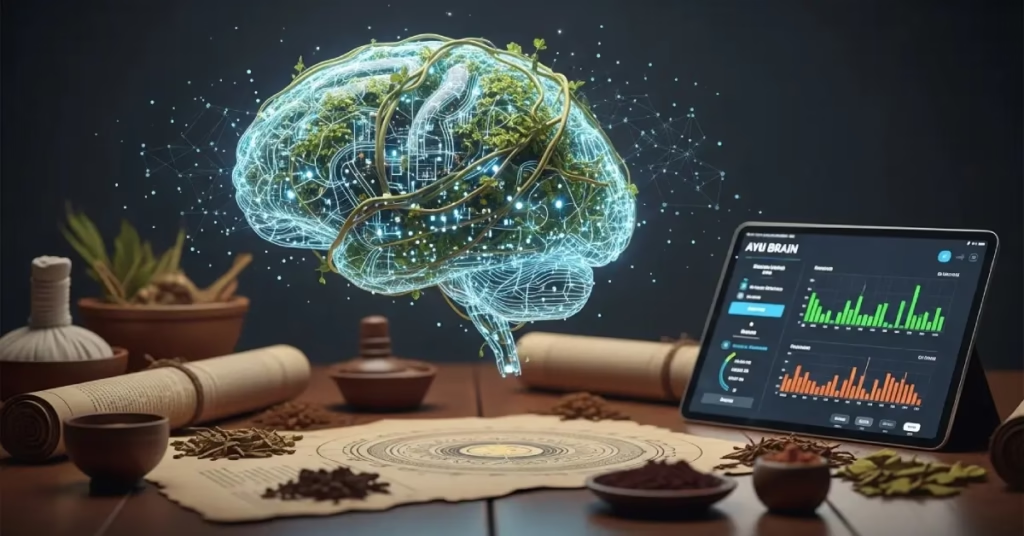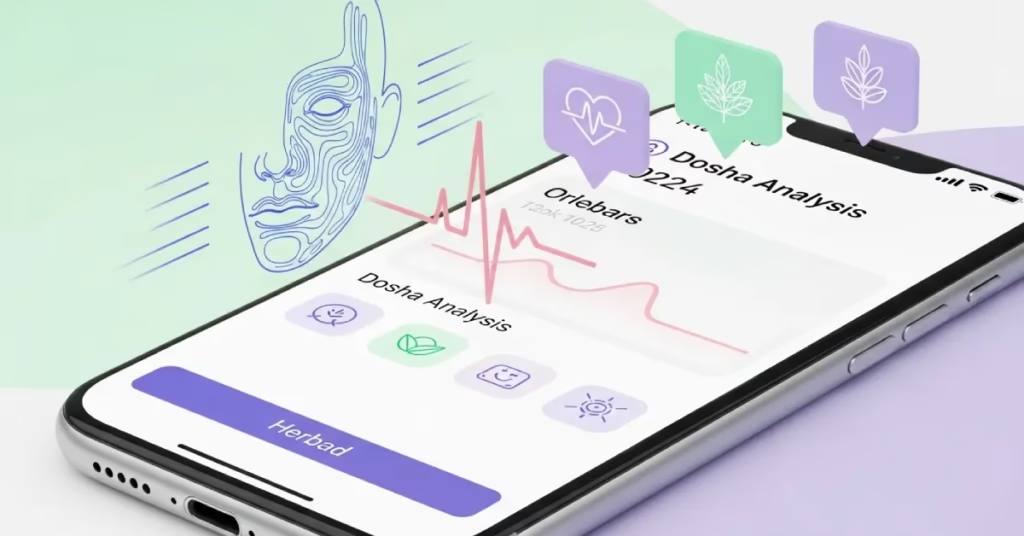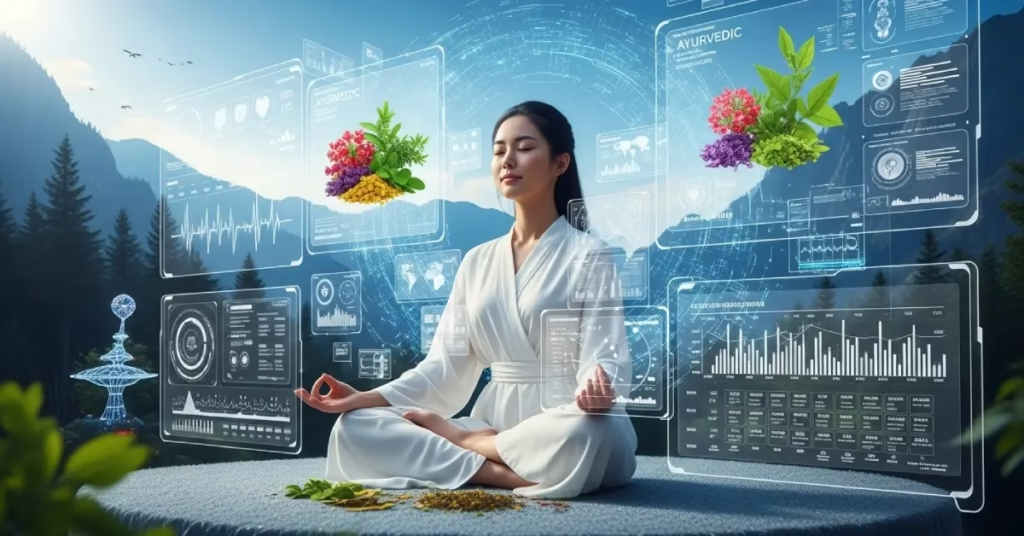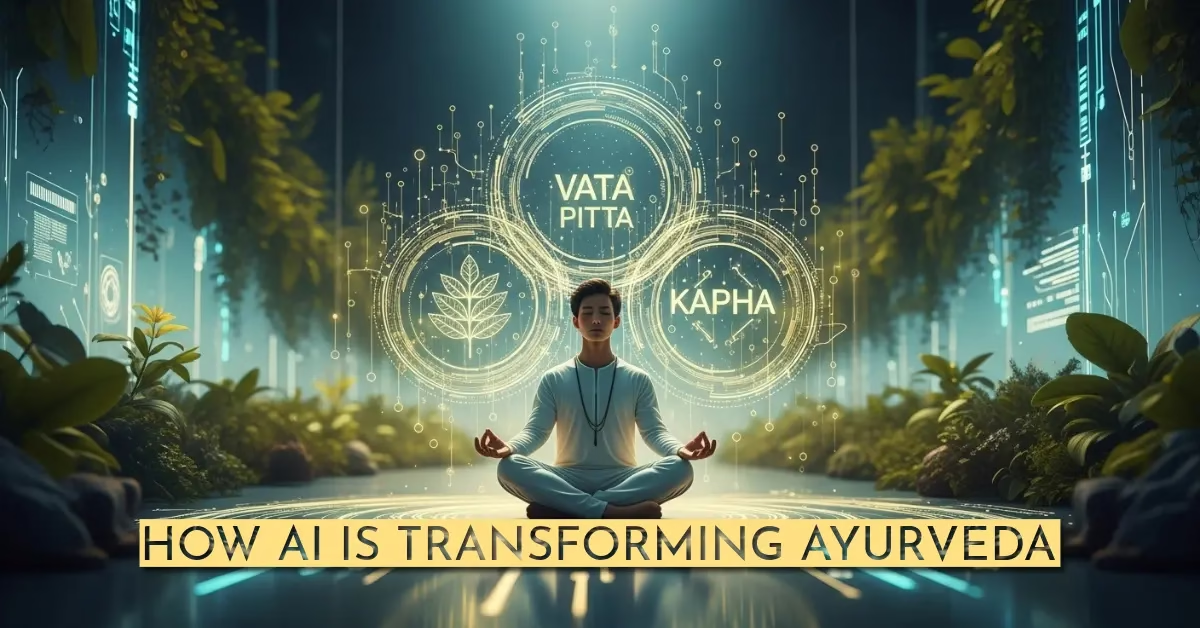Can your phone read your dosha? Six months ago, Priya—a busy Mumbai marketing executive—would’ve laughed at the idea. Yet here she is, holding her smartphone while its camera scans her face. In 90 seconds, it tells her what used to require a 2-hour clinic visit: her dominant Pitta-Kapha constitution, aggravated Vata from stress, and exactly which herbs and yoga poses could rebalance her.
Ayurveda, India’s 5,000-year-old “science of life,” teaches that health stems from balancing three bioenergies (doshas):
- Vata (air/space): governs movement
- Pitta (fire/water): controls digestion & metabolism
- Kapha (earth/water): regulates structure & immunity
Traditionally, pulse reading, facial analysis, and lifestyle questioning helped experts assess your dosha blend. But in 2025, artificial intelligence is bridging ancient wisdom and modern life. Algorithms now decode skin scans, voice patterns, and health data to deliver personalized Ayurvedic insights faster—and often cheaper—than ever.
“AI isn’t replacing Ayurveda’s human touch—it’s expanding its reach,” notes Dr. Vijay Murthy, Kama Ayurveda’s Scientific Advisor. “We’re making personalized wellness accessible to millions who’d never walk into a clinic.

What Is Dosha Analysis—and Why It Matters
Imagine your body as a unique ecosystem. Ayurveda believes your health thrives when your three core energies—Vata, Pitta, and Kapha—are in harmony. Think of them like internal weather patterns:
- Vata (airy + creative) out of balance? You might feel anxious or fatigued.
- Pitta (fiery + focused) overactive? Heartburn or irritability can flare up.
- Kapha (grounded + calm) excessive? You may feel sluggish or congested.
Dosha analysis identifies your dominant energy blend—your prakriti (natural state)—and detects current imbalances (vikruti). This isn’t just theory; it’s practical. Knowing your dosha profile helps you:
- Eat smarter (e.g., Pittas cool down with mint; Vatas warm up with ginger)
- Move better (Kaphas need energizing workouts; Vatas benefit from yoga)
- Reduce stress (Pittas avoid overheating; Kaphas need stimulation)
The Modern Struggle with Tradition
Traditionally, vaidyas (Ayurvedic doctors) assessed doshas through:
- Observation (skin, eyes, tongue)
- Touch (pulse, temperature)
- Deep interviews (habits, emotions, diet)
But today? Few have hours for consultations or access to experts. Self-assessment quizzes online are often vague. Result: Generic advice that misses your body’s real-time needs.
AI solves this gap—making personalized dosha analysis fast, accurate, and available anytime.
“My dosha shifted during monsoon, but I didn’t realize until my app flagged my rising Vata symptoms. It suggested warm oil massages—game-changer!”
—Rahul, 34, Bangalore
How to Make Herbal Steam Inhalation for Cold Relief at Home – A step-by-step method using herbs you likely already have.

Enter AI: How Technology Is Changing Dosha Diagnosis
Forget crystal balls—AI uses real data. Traditional dosha analysis relies on human senses. AI, however, crunches thousands of data points using machine learning. Think of it like a weather app predicting storms: instead of satellite images, it analyzes your biological signals to forecast dosha imbalances.
How AI “Reads” Your Doshas:
Here’s the magic behind your screen:
- Smart Quizzes → Smarter Insights
Apps ask dynamic questions (e.g., “Does spicy food make you sweat excessively?”). AI cross-references answers with clinical data, spotting patterns humans might miss. - Biometric Scans
- Facial Analysis: Cameras detect skin texture, dark circles, or dryness (Pitta/Kapha clues).
- Voice AI: Vocal pitch/tremors hint at Vata agitation.
- Wearables: Heart rate variability (HRV) sensors track stress-linked Pitta spikes.
- Pulse + Symptom Mapping
Tools like VedaPulse use fingertip sensors to measure heart rhythm. AI compares it to a database of 10,000+ “dosha-specific” pulses.
Example: When Ananya (28) logged fatigue and dry skin, her app combined facial scans + quiz answers. It found hidden Vata imbalance—triggered by her new coffee habit—and suggested warm almond milk instead.
Why AI Excels Where Humans Can’t:
- Scale: Analyzes global data (e.g., “How do monsoon rains affect 10,000 Vata types?”).
- Precision: Detects subtle shifts (like stress-induced Pitta rise before acidity hits).
- Adaptability: Learns from user feedback (e.g., if ginger worsened your heartburn, it adjusts future advice).
“AI is a diagnostic co-pilot. It handles data; practitioners handle wisdom.”
—Dr. Smita Naram, Ayushakti Clinics
Ayurvedic Turmeric Tulsi Tea Recipe – A powerful immune-boosting drink rooted in Ayurvedic wisdom.

Best AI-Powered Dosha Tools Available Today
Ready to find your dosha without booking a clinic visit? These AI-powered platforms are making personalized Ayurveda accessible anytime, anywhere. Here’s a quick comparison of top tools:
| App/Platform | Key AI Features | Wellness Offerings |
|---|---|---|
| NirogStreet | Voice analysis + symptom tracker | Live doctor chats + custom herb plans |
| Ayusoft | Facial scan + pulse diagnostics | Dynamic diet schedules + yoga sequences |
| VedaPulse | Heart-rate variability sensors | Stress maps + dosha-balancing music |
| YouVeda | Daily habit tracker + climate AI | Localized seasonal routines |
Let’s break them down:
- NirogStreet
- How it works: Chatbot asks symptom-based questions while analyzing vocal tone
- Personalizes: Herb recommendations based on local availability
- Best for: Connecting with certified vaidyas after AI assessment
- Ayusoft
- How it works: 60-second facial scan detects skin texture/undereye changes
- Personalizes: Generates weekly meal plans using dosha-specific ingredient database
- Best for: Visual learners who prefer “show don’t tell” diagnostics
- VedaPulse
- How it works: Wearable sensor tracks heart rhythm patterns (Pitta spikes = rapid pulses)
- Personalizes: Curates sound therapy (e.g., flute for Vata, ocean for Kapha)
- Best for: Tech enthusiasts wanting quantifiable data
- YouVeda
How it works: AI cross-references your location’s weather/humidity with dosha needs- Personalizes: Suggests abhyanga (oil massage) blends for your climate
- Best for: Travelers or those in extreme seasons
Pro Tip: Most apps offer free basic dosha quizzes—try 2–3 to compare results!
Ayurvedic Diet to Support Healthy Blood and Circulation – Learn what to eat to support your body’s internal balance.
Benefits of Personalized Ayurveda Through AI
Imagine getting real-time dosha alerts like weather updates for your body. That’s the power of AI-driven Ayurveda—and it’s changing lives beyond faster quizzes. Here’s why tech-savvy wellness seekers are embracing it:
5 Game-Changing Advantages:
- Lightning-Fast Insights
Traditional: Weeks for clinic appointments + observation.
AI: 90-second scans + instant reports (e.g., Ayusoft’s facial analysis). - Hyper-Personalization
AI cross-references:- Your symptoms
- Local climate
- Lifestyle logs (sleep, meals, stress)
Result: “Raj, your Pitta is spiking. Skip chili today → try cucumber raita.”
- 24/7 Prevention
Wearables track early imbalance signs:- Vata: Irregular sleep → bedtime oil routine reminder
- Kapha: Low activity → dynamic yoga sequence
→ No more “waiting till it’s a problem.”
- Data-Backed Accuracy
Machine learning compares your profile with millions of cases:
*”87% with your voice tremor + dry skin had Vata imbalance.”* - Democratized Access
Rural users, non-Sanskrit speakers, or busy parents get:- Low-cost diagnostics
- Multilingual advice (NirogStreet offers Hindi/English/Tamil)
Real impact: When Hyderabad’s heatwave spiked, YouVeda users got Pitta-cooling recipes before acidity hit.
But Is It Reliable?
AI excels at spotting patterns, but human intuition still rules for complex emotional roots (like grief-triggered Kapha stagnation). As Dr. Murthy reminds us:
“AI democratizes Ayurveda—but your vaidya deciphers the soul behind the data.”
Limitations & Ethical Concerns
While AI makes Ayurveda accessible, it’s not a cure-all crystal ball. Let’s unpack the real limitations—and why your intuition still matters.
Key Concerns to Consider:
- The “Cold Data” Problem
AI detects physical symptoms but misses:- Emotional nuances (e.g., Is your Pitta rage from heat… or a toxic job?)
- Spiritual imbalances (like purpose-loss affecting Kapha)
- Accuracy Gaps
- Facial scans struggle with darker skin tones (training data bias)
- Generic advice if sensors misread (e.g., mistaking dehydration for Vata)
Always cross-check sudden recommendations!
- Privacy Risks
Your health data—voice, face, pulse—could be:- Sold to advertisers (“Pitta-dominant? Buy this cooling supplement!”)
- Hacked (especially with India’s evolving Digital Personal Data Protection Act)
- Over-Reliance Danger
Ignoring body signals because “the app didn’t alert me” delays critical care.
The Golden Rule: AI + Human Wisdom
Ayurvedic practitioner Deepika Sharma puts it plainly:
“Use apps like a thermometer—they measure, but don’t diagnose. When your dosha report says ‘severe imbalance,’ see a vaidya. Algorithms can’t hold your hand through healing.”
Always choose apps that:
- Allow data deletion
- Offer expert follow-ups (like NirogStreet)
- Cite research sources

The Future of AI in Ayurveda
Your dosha forecast for 2030? Think predictive weather apps—but for your health. As AI evolves, it’s set to transform Ayurveda from reactive to proactive wellness. Here’s what’s brewing:
3 Revolutionary Shifts Coming Soon:
- Predictive Dosha Care
AI will forecast imbalances before symptoms strike:- Wearables tracking sleep + digestion → “Vata likely to spike in 3 days: start warm oil massages now”
- Climate data + calendar sync → “Monsoon incoming! Kapha-balancing protocol activated”
- DNA + Dosha Fusion
Startups like Prakriti Genomics are merging:- Ayurvedic prakriti profiles
- Genetic markers (like COMT genes for stress response)
→ “Your genes show slow detox → Pitta-specific herbs + customized panchakarma”
- Ambient Healing Ecosystems
Imagine:- Smart mirrors scanning your face during morning routines
- Yoga mats suggesting poses based on your real-time Kapha levels
- AI kitchens adjusting recipes as your dosha shifts
“Soon, your home will become your vaidya,” predicts Ayusoft’s CTO Rajiv Mehta. “AI won’t just analyze—it’ll create healing environments.”
The Big Dream: Global Dosha Maps
Research institutes are building:
Real-time dosha imbalance maps (like pollution trackers) showing:
- Regional stress hotspots (Pitta zones)
- Seasonal vulnerability alerts (Vata-aggravating winds)
- Herbal supply chain optimizations
Final Thoughts: Human Touch in a Digital Age
Your phone knows your dosha—but does it know you? As we embrace AI’s precision, let’s remember Ayurveda’s heartbeat: the sacred dance between shastra (science) and sanskriti (culture).
The Unreplaceable Human Essence
An algorithm might spot your Vata imbalance, but it won’t:
- See the tears behind your insomnia
- Feel the warmth of your palms during pulse reading
- Smell the neem in your garden that sparks a childhood memory of healing
“Ayurveda isn’t data points—it’s the stories our bodies whisper,” says Dr. Vinod Kumar, Kerala-based vaidya. “AI hears words; humans hear meaning.”
How to Harmonize Tech + Tradition
| Use AI For | Turn To Humans For |
|---|---|
| Daily dosha tracking | Life-altering imbalances |
| Diet/lifestyle reminders | Emotional/spiritual crises |
| Preventive alerts | Panchakarma or major detox |
Try this: After your next app scan, journal one thing the data missed—like how turmeric tea reminds you of your grandmother’s kitchen. That’s where true balance lives.
The Path Forward
AI in Ayurveda isn’t about cold machines replacing warm hands. It’s about:
- Phones that extend a vaidya’s reach to villages without clinics
- Global wisdom sharing (a Kerala elder’s pulse knowledge informing a Berlin teen’s app)
- Freeing practitioners from routine diagnostics to deepen healing conversations
So, explore those flashy dosha apps—but when monsoon winds rattle your bones, still seek the vaidya whose hands have read pulses for 40 monsoons. That’s how ancient wisdom thrives in the digital age: with roots in earth and eyes on the stars.
